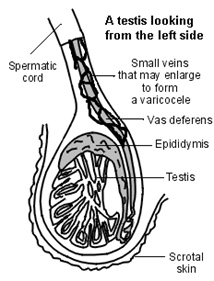Varicocele Embolisation Fact Sheet
What is Varicocele Embolisation?
A varicocele is a collection of enlarged (dilated) veins in the scrotum – similar to varicose veins that occur in the legs.
It occurs next to and above one or both testicles. A varicocele often produces no signs or symptoms and is rarely painful. With time, varicoceles may enlarge and become more noticeable.
An embolisation is a procedure performed to eliminate blood flow to the abnormal veins (varicies) and redirect blood flow to normal veins.
A specialist known as an Interventional Radiologist often performs this procedure.
It involves the injection of contrast (x-ray dye) to visualise both the normal and abnormal veins of the testes. The contrast is injected through a thin plastic tube called a catheter, which is passed through a sheath inserted into the femoral vein.

To learn more about varicocele embolisation, read our procedures page here.
Why do I need this procedure?
Your Doctor has asked for this procedure to be performed because you may experience some or all of the following;
- Increase size with standing or physical exertion
- In young men, the presence of a varicocele impairs sperm production and can often be improved with treatment.
- Very rarely pain.
What should I expect?
- The procedure can take between 20 – 60mins.
- The contrast can cause a warm flushing or burning sensation. It only last for a few seconds and stops once the contrast has stopped being injected. Please ring MIVIR if you have a known allergy to Iodine or contrast.
- You may be required to take some time off work – please let the nurses know so they can organise a medical certificate for you. An attendance certificate can be provided if required.
- Please make sure you have someone to pick you up after your procedure. You procedure will be cancelled if you don’t have an escort. Please contact MIVIR as soon as possible if this cannot be arranged.
On the day of your Procedure
You will need to present to the Day Procedure Unit on the day of your procedure. This will allow the nurses time to complete your admission paperwork and any other tests that may be required such as blood tests or pre-medication.
You will be required to fast for 4 hours before your procedure – this means no food or fluids. You may take any regular medication with a small sip of water. Please continue to take your blood pressure medication. Please bring all of your regular medications with you.
Please contact MIVIR if you are taking medication for the following;
- Diabetes,
- Stroke,
- Heart Conditions such as a Heart Attack or Atrial Fibrillation.
Useful Links
The following links also provide reliable information:
Varicocele Embolization – Radiology Info
Varicocele Embolisation FAQs – Varicoceles.com
Percutaneous Varicocele Embolization – National Library of Medicine
Author: Dr John Vrazas
